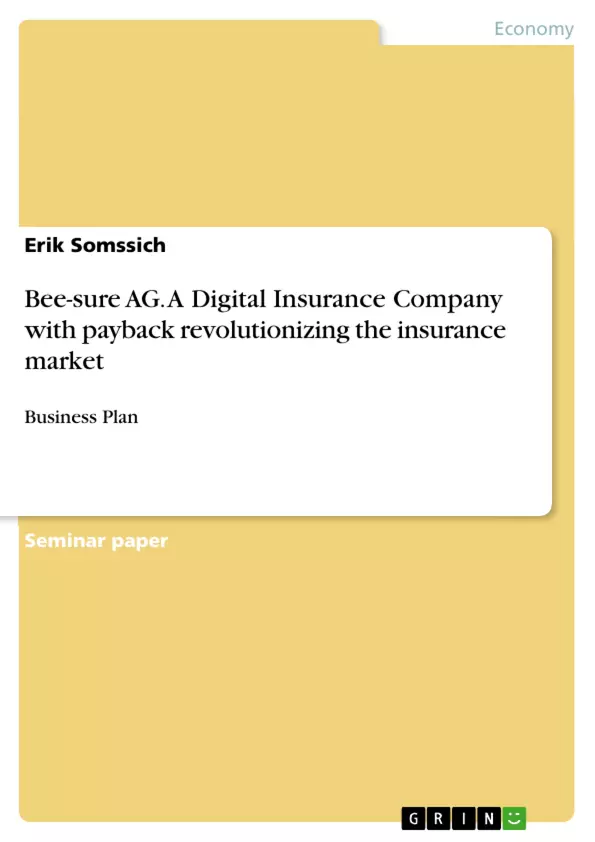This work contains an entire business plan of the start-up-company Bee-sure AG including the financial forecast for the first five years and the further plans for development. The company's headquarter is planned to be in Cologne, Germany and the legal form will be an insurance corporation (AG). After founding, the company will apply for a property & casualty (P&C) insurance license in Germany at the Federal Financial Supervisory Authority (BaFin). Bee-sure AG will be an entirely new type of insurance company in Germany. By combining high technology with efficiency and transparency Bee-sure will be the first fully digitalized insurance company, meaning completely without paperwork. By this way an insurance experience is created that is very fast both in the process of applying and the process of claims handling. In addition, the products will be more individual and flexible but still very affordable.
Inhaltsverzeichnis (Table of Contents)
- Executive Summary
- Table of contents
- List of abbreviations
- List of figures
- List of tables
- Introduction
- Problem and objective
- Scope of work
- Company Description
- Vision & Mission
- Vision
- Mission
- Product & Service Description
- Products
- Living
- Liability
- Disability
- Situational insurance products
- Service offerings
- Living service offerings
- Disability service offerings
- Additional services
- Products
- Industry Analysis
- Industry overview
- Barriers to entry the market
- External influencing factors (PEST analysis)
- Political factors
- Economic factors
- Social factors
- Technological factors
- Marketing Plan
- Social Media Marketing
- Referral Marketing
- Cross-selling with predictive Marketing
- Sales Plan
- Competitive Analysis
- Competitor Overview
- Competitor Analysis (SWOT-Analysis)
- Strengths
- Weaknesses
- Opportunities
- Threats
- Operations Plan
- Location and Infrastructure
- Policy administration and claims handling
- Operational team
- Management Team
- Financial Plan
- Financial Summary
- Current Ownership Summary
- Funding Request / Terms of Investment
- Sources and uses of funds
- Sources of funds
- Uses of funds
- Exit Strategy
- Management-Buy-Out / new long term investor
- Takeover by a competitor
- Projected Financial Statements
- Costs before start of operations
- Financial assumptions
- Projected profit and loss statements
- Conclusion and Outlook
- References
Zielsetzung und Themenschwerpunkte (Objectives and Key Themes)
This study programme examines the development of a digital insurance company, Bee-sure AG, with a focus on its potential to revolutionize the insurance market. The study explores the company's innovative approach to customer needs, emphasizing affordable, individual, and flexible products combined with efficient digital processes. The goal is to analyze Bee-sure AG's business model, market entry strategy, and financial projections to assess its viability and potential for success in the competitive insurance landscape.
- Digitalization of the insurance sector
- Customer-centric approach and innovative product offerings
- Cost-effective business model and revenue generation strategies
- Market entry strategy and competitive analysis
- Financial planning and potential for growth
Zusammenfassung der Kapitel (Chapter Summaries)
- Executive Summary: Introduces Bee-sure AG as a fully digitalized insurance company offering affordable, individual, and flexible products. Highlights the company's cost-effective structure, customer-centric approach, and revenue sharing model through a "payback" system.
- Introduction: Outlines the problem addressed by Bee-sure AG, which is the lack of digitalization in the insurance industry. Defines the scope of the study and provides an overview of the company's background.
- Vision & Mission: Presents Bee-sure AG's vision and mission statements, outlining its ambition to revolutionize the insurance market and its commitment to providing customer-centric solutions.
- Product & Service Description: Details the products and services offered by Bee-sure AG, including living, liability, and disability insurance, as well as additional services like health and financial advice.
- Industry Analysis: Provides an overview of the insurance market, analyzes barriers to entry, and conducts a PEST analysis to identify external influencing factors affecting the industry.
- Marketing Plan: Describes the company's marketing strategies, focusing on social media marketing, referral programs, and cross-selling opportunities.
- Sales Plan: Briefly outlines the company's sales strategy and approach to customer acquisition.
- Competitive Analysis: Conducts a SWOT analysis of Bee-sure AG's competitors, identifying their strengths, weaknesses, opportunities, and threats.
- Operations Plan: Explains the company's operational setup, including location, infrastructure, policy administration, and claims handling processes.
- Management Team: Provides information about the management team responsible for leading Bee-sure AG.
- Financial Plan: Details the company's financial projections, including funding requests, sources and uses of funds, exit strategies, and projected financial statements.
Schlüsselwörter (Keywords)
This study focuses on the key concepts of digitalization, insurance, customer-centricity, cost-effectiveness, market entry strategies, competitive analysis, financial planning, and revenue models. The study explores the potential of Bee-sure AG as a digital insurance company and its impact on the insurance industry.
- Citar trabajo
- Erik Somssich (Autor), 2017, Bee-sure AG. A Digital Insurance Company with payback revolutionizing the insurance market, Múnich, GRIN Verlag, https://www.grin.com/document/437735



